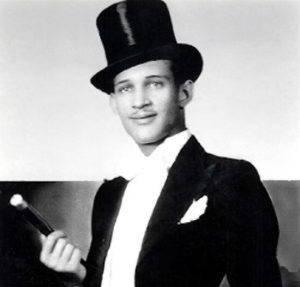
Leonard Reed
*Leonard Reed was born on this date in 1907. He was a Black Native American dancer, composer, choreographer, and showman.
Born in a tepee at Lightning Creek, Oklahoma, his mother, who died when he was two, was half Choctaw Cherokee Indian and half Black. His father, who was white, and whom he also never knew, had raped her. His great-grandmother raised him until he was 11 when he was placed in a foster home in Kansas City, Missouri. He was soon running with the wrong crowd and, at 13, was threatened with a four-year sentence in reform school for buying alcohol under age. However, the headmaster of his high school knew that Leonard was being abused by the guardian of the foster home and offered to adopt him if he were not jailed. As a teenager, Reed had a weekend job selling popcorn at a theater in Kansas City. The Charleston Dance was sweeping the United States, and he learned how to do the Charleston by copying the performers on stage.
Reed's professional career was short, lasting only from 1922 until 1933. His tremendous success in that period and the reason it ended had a common origin: the tall, fair-complexioned, blue-eyed Reed was, in fact, of mixed Black and white blood. Until he was exposed, he could pass for both races and, in the age of segregation, worked both the Black theaters that were the laboratories of tap, as well as the more lucrative - but white - vaudeville venues. He began in entertainment as a specialist Charleston dancer, doing three-minute slots in the shows that toured the Black theater circuits of the South and Mid-West.
In 1925, while visiting Cornell University in New York, Reed entered and won a Charleston competition for whites. The victory proved to be his passport to the white theaters as well. Soon, he was a regular visitor to the Hoofers Club on 7th Avenue in Harlem, where dancers like Bill Robinson traded steps and styles with all comers. Reed started working for the Whitman Sisters, acknowledged having the best Black revue, and partnered with the similarly light-skinned Willie Bryant: "Reed & Bryant - Brains as well as Feet." Reed, with his dance partner Willie Bryant, invented the shimmy routine as a flashy finale to their dance act in the late 1920s.
Reed and Bryant devised a new finale for their eight-minute show, a step of simple heel-and-toe combinations danced to four eight-bar choruses - tunes such as Tuxedo Junction or Ain't What You Do. Like most forms of tap, it was probably an adaptation of an earlier dance, but at some point, Reed, who always retained traces of his flamboyant Charleston style in his taps, added a shimmy of the shoulders, perhaps at the prompting of the Whitman girls. He and Bryant originally called it "Goofus," but it became known as the Shim Sham after a club where they regularly appeared. Its simplicity and suitability as a line dance, especially with the newly popular swing music, meant clubgoers quickly picked up and disseminated it. It has endured ever since and has been called the anthem of tap.
In their book "Jazz Dance," Marshall Winslow Stearns and Jean Stearns describe it as "a one-chorus routine to a 32-bar tune, with eight bars each," consisting of the double shuffle, crossover, an up-and-back shuffle, and then another move, characterized as "falling off a log." Reed and Bryant were rarely out of work for the next three years, appearing in both Black and White venues, notably the Palace Theater New York. While a teenager at a white dance contest, Reed had once been revealed as black by an usherette and had been chased from the hall. In 1933, the secret of his mixed blood again slipped out, and he found himself barred from the White vaudeville circuit. After discovering he was Black and Cherokee, Reed turned to production and choreography.
In 1934, he staged Rhythm Bound, with 40 singers, at the Harlem Opera House, and from the mid-Thirties, worked in-house at the Cotton Club, arranging music and producing shows for Cab Calloway, Duke Ellington, Ethel Waters, Billie Holiday, and the Nicholas Brothers. In 1937, he was injured in a car accident, and so was unfit for service during the Second World War, during which he spent entertaining troops. He later wrote music for Lionel Hampton and Ella Fitzgerald. From 1950 until 1960, he managed the Apollo Theatre in Harlem, which was greatly celebrated for its talent shows. In 1951, he married Barbara De Costa.
Among those that Reed helped to unearth was Dinah Washington. During the 1960s, he choreographed dances for many Motown artists. Reed was also the manager of Joe Louis's appearances for many years and helped the boxer work up the nightclub comedy act for which he was also known. Both Reed and Louis were good golf players, and Reed is credited with becoming the first Black player to have taken part in a PGA tournament when, in San Diego in the mid-1940s, he was accidentally given a tour card by an official who thought he was white. Tiger Woods has praised Reed's many years of work against segregation in golf.
Reed lived in southern California and continued to teach tap dancing until his late nineties. 2000 Reed received a lifetime achievement award from the American Music Awards. Two years later, he received an honorary doctor of Performing Arts degree from Oklahoma City University. Leonard Reed, a tap-dance pioneer, died on April 5, 2004, of heart failure. He was 97. He is survived by his wife, Barbara; a daughter; a granddaughter; and two great-grandchildren.
Reference:
Theater Dance Legends